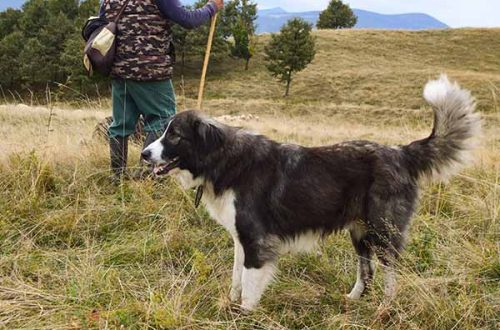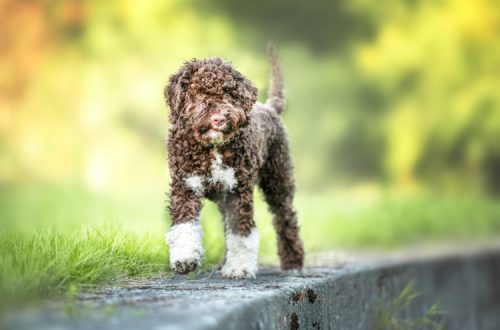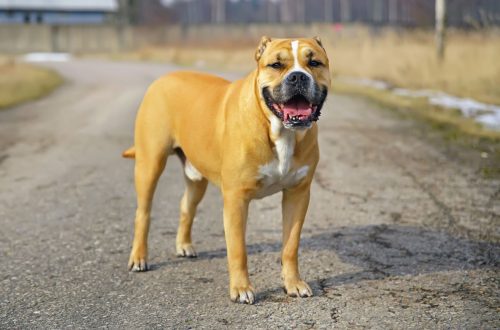
Staffordshire Bull Terrier
Other names: staff , staff bull , bull and terrier
The Staffordshire Bull Terrier is a short, broad-chested companion dog, the final “product” of mating between a Bulldog and an English Terrier. Initially, the breed was used for rat-baiting and participation in dog fights.
Contents
- Characteristics of Staffordshire Bull Terrier
- Basic moments
- History of the Staffordshire Bull Terrier
- Video: Staffordshire Bull Terrier
- Staffordshire Bull Terrier breed standard
- Photo Staffordshire Bull Terrier
- Personality of the Staffordshire Bull Terrier
- Education and training
- Maintenance and care
- Health and disease of Staffordshire Bull Terriers
- How to choose a puppy
- Photo of Staffordshire Bull Terrier puppies
- Staffordshire bull terrier price
Characteristics of Staffordshire Bull Terrier
| Country of origin | England |
| The size | average |
| Growth | 36-41 cm |
| Weight | 11–17 kg |
| Age | up to 14 years old |
| FCI breed group | Terriers |
Basic moments
- The Staffordshire Bull Terrier has several alternative names. For example, representatives of this breed are often referred to as staff bulls or simply staffy.
- The hunting instinct in dogs is poorly developed, as are watchdog abilities, so frightening burglars with the help of a Staffbull is a waste of time.
- The Staffordshire Bull Terrier has been the living mascot of the Prince of Wales’ Staffordshire Regiment for decades.
- The Staffbull is not the kind of dog that will watch TV shows with you for days, although sometimes these energetic strong men are not averse to relaxing. The breed lives at a dynamic, if not to say accelerated, pace, and will always prefer a good run or game to pleasant doing nothing.
- Staffordshire Bull Terrier males are more aggressive and prone to rivalry among themselves, so keeping two “boys” in one apartment will require patience and endurance from the owner.
- Staffordshire Bull Terriers are dogs whose intelligence and quick wits need to be constantly trained and developed. In addition, they need early socialization.
- Representatives of this breed have a high pain threshold, so staffies tolerate even serious injuries relatively calmly.
- Both severe hypothermia and overheating are contraindicated for Staffordshire Bull Terriers, which is why animals are recommended for home and apartment maintenance.
- Staffbulls are very athletic and, with timely training, show high results in dog frisbee, agility, freestyle, and sometimes in coursing.

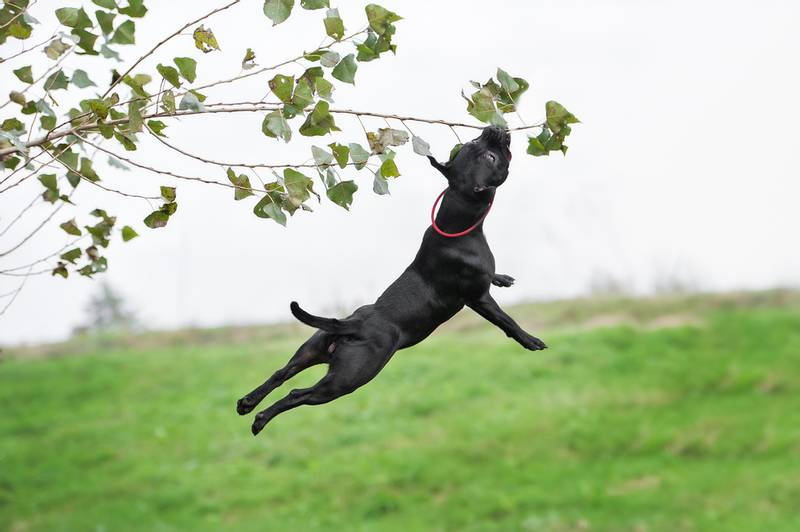

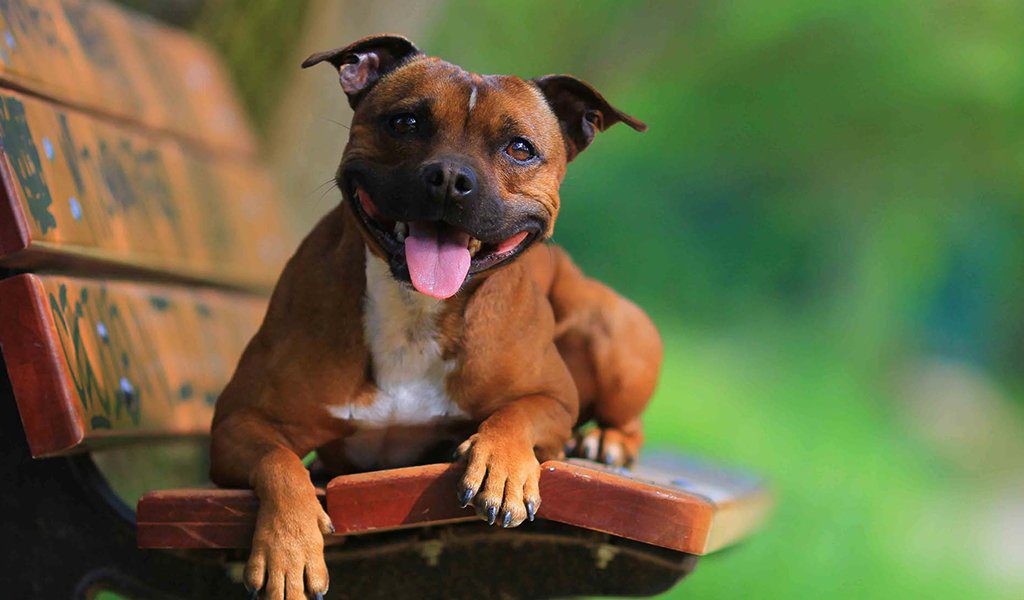
The Staffordshire Bull Terrier is outwardly serious, but sociable at heart, a healthy man who loves everything connected with physical activity. He is a little cocky, moderately stubborn and sometimes willingly plays the alpha male, but all these are such trifles compared to the devotion of the breed to the owner and family. Almost all Staffordshire Bull Terriers have great intellectual potential, which must be developed in a timely manner in order to grow up a smart and understanding friend. Staffbulls are called the best dogs for those who like to tinker with training on their own, raising a pet “for themselves”.
History of the Staffordshire Bull Terrier
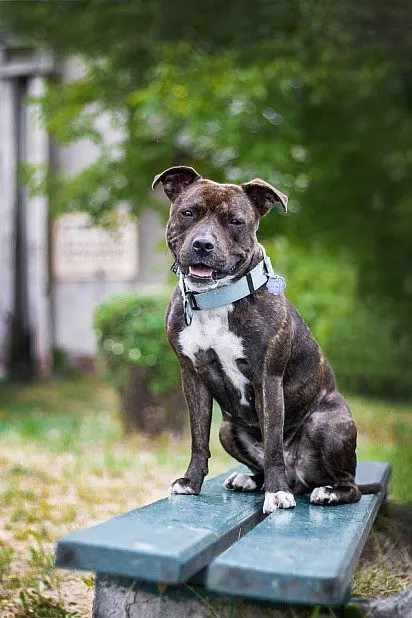
The Staffordshire Bull Terrier is a breed whose birth was dictated not by practical necessity, but by greed. At the beginning of the 19th century, a new type of entertainment came into fashion among the English poor – dog fighting. Every weekend, crowds of onlookers flocked to some patch, where they watched with delight how the owners of animals pit their wards against each other. Here, bets were made to win, which only further fueled interest in a wild, but such an exciting “sport”.
At first, bulldogs were predominantly in the ring, which were later joined by representatives of the terrier group. However, it was difficult for the animals to keep the attention of the audience. Fed up with the standard persecution, the people longed for a cruel show, and received another dog showdown with techniques studied up and down. In order not to lose the viewer, and with it a stable income, the owners of the four-legged fighters had to dodge and experiment with the genetic base. So, a hitherto unknown variety of dogs called bull and terriers began to appear on the sites.
Representatives of the new breed, born in the course of crossing a bulldog with an English terrier, surpassed their ancestors in the art of fighting, and indeed in everything that concerned resourcefulness, passion and speed of reaction. In addition to outstanding fighting qualities, the animals also showed a talent for mice, so the demonstrative baiting of rats with the participation of a bull and terrier quickly turned into a favorite sight of the English lower classes. A dog named Billy was especially successful in this business, in 1823 he swung at a world record. In just over five minutes, the dog strangled 100 rats, who, in turn, also did not waste time and fiercely attacked the enemy.
Further breeding of bull-and-terriers proceeded spontaneously. In the “creative experiments” no one limited the breeders, so soon three intrabreed types of staffies were formed in England:
- cradles are compact, strong animals with a developed skeleton;
- warlaston – medium-sized, moderately well-fed dogs with short bulldog legs;
- The Warsol is the type closest to the terrier, with long limbs and a dry constitution.
Staffordshire Bull Terriers acquired their modern look only in the second half of the 19th century, and they managed to acquire a breed standard only in 1935, after dog fighting was outlawed in the UK. By the way, the same cradley type was declared the standard of the breed’s appearance, endowing its representatives with a stocky constitution and characteristic bonyness.
Video: Staffordshire Bull Terrier
Staffordshire Bull Terrier breed standard
The Staffordshire Bull Terrier is a smooth-coated, stocky stout with a broad chest and an intelligent, scanning gaze. You do not need to be a super cynologist to note the external resemblance of representatives of this family with pit bulls and amstaffs . At the same time, it is impossible to call the English staffies an exact copy of their overseas “colleagues”. The breed has a lot of its own distinguishing features, so if you see a Staffbull at least once and talk to him for half an hour, in the future you are unlikely to confuse him with someone else. In particular, the Staffordshire Bull Terrier is much more smiling than the same Amstaffs and Pit Bulls (developed cheek muscles + wide skull). And he is significantly inferior to them in growth.
Head
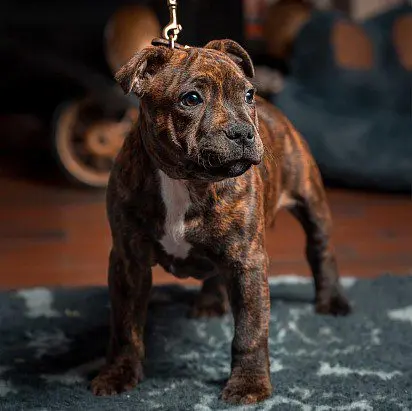
The skull of the animal gives the impression of a compact and wide, the stop is clearly drawn. The muzzle of the Staffbull is noticeably shorter than the head.
Jaws and teeth
The strong, developed jaws of the Staffordshire Bull Terrier have an outstanding grip. The teeth of the dog are white, very large. The bite is correct, complete.
Nose
Lobe of normal size, painted in a rich black hue.
Eyes
Ideally, the eyes of the animal should be round, straight set, as dark as possible. But in reality, individuals with a lighter shade of the iris that is in harmony with the coat color are not so rare.
Ears
The small, semi-erect ears of the Staffordshire Bull Terrier are shaped like a flower petal.
Neck
One of the distinguishing features of the breed is a short, dense neck, which makes the silhouette of the dog even more solid and squat.
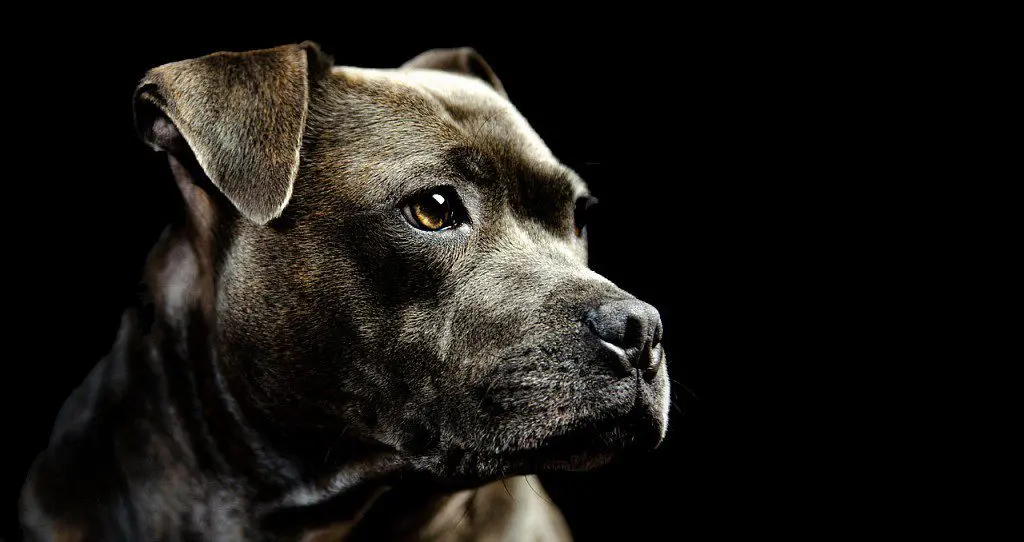
Frame
The body of the Staffbull is somewhat stretched, strongly knocked down. The back is perfectly straight, the chest is deep, greatly extended in breadth.
limbs
The forelegs are slender, with the shoulder blades laid back, strong wrists and paws looking outward. The hindquarters of the dog are more muscular, with markedly sloping lower legs and low hocks.
Tail
The tail of the Staffordshire Bull Terrier is relatively short, not curled, set low.
Wool
The coat is of a glossy type, very dense and short.
Color
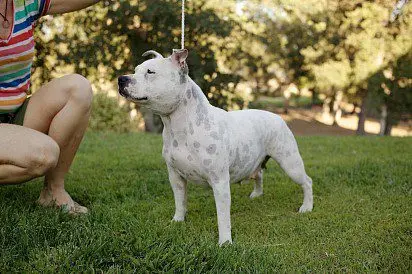
- Solid black or combined with white.
- Red: solid or with white spots.
- Solid fawn or diluted white.
- Solid blue or combined with white.
- Brindle or brindle with white.
- White: solid, also with black, red, fawn, blue spots and brindle.
Defects and defects of the breed
Often among the Staffordshire Bull Terriers you can find such external flaws as a flat chest, too bright eyes, dewlap on the neck, slight clubfoot or limbs, hanging ears. Depending on the degree of severity, the listed defects may be the reason for lowering the rating of the animal at the exhibition or the reason for the ban on participation in it. At the same time, cryptorchidism, bite defects (undershot bite, undershot bite, misalignment of the lower jaw), liver and black and tan colors, as well as amble remain the main disqualifying vices for staffies.
Photo Staffordshire Bull Terrier
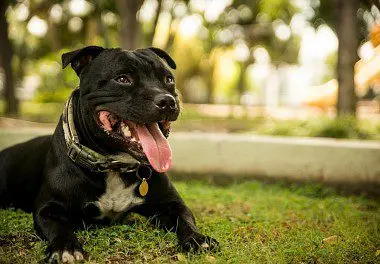
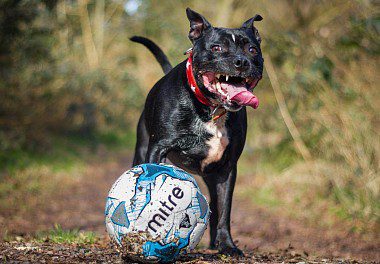
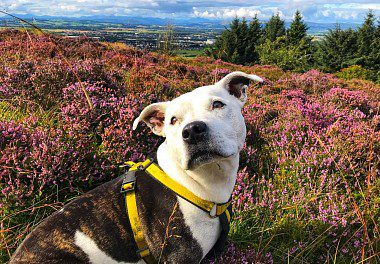

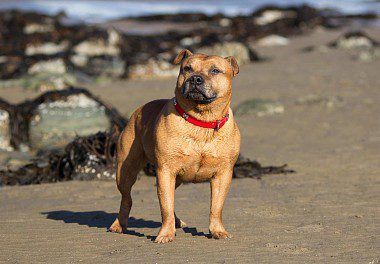
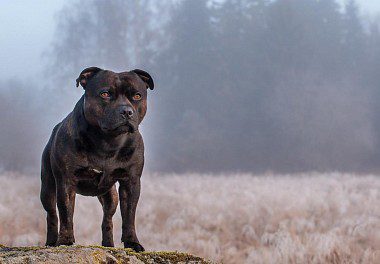
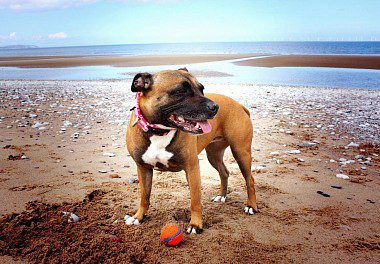
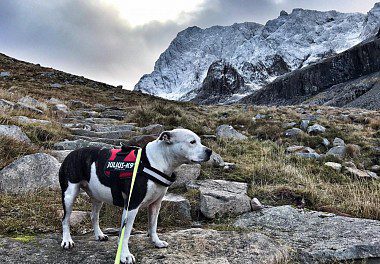
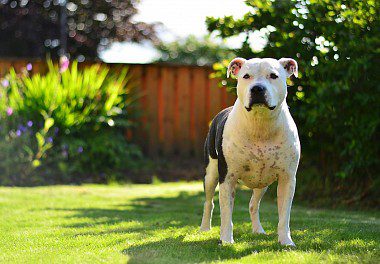
Personality of the Staffordshire Bull Terrier
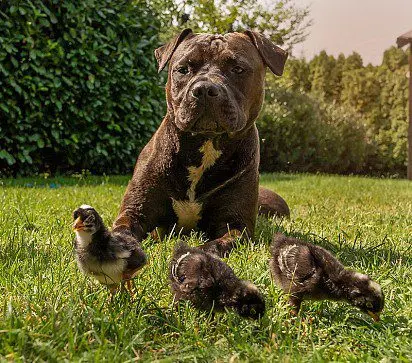
The fighting past of the breed, if it affected the character of its modern representatives, is not as significant as one might expect, therefore today’s Staffordshire Bull Terriers are quite peaceful and friendly creatures. Moreover, this is one of the most human-oriented dogs, although its appearance hints at completely opposite qualities. A mentally healthy and well-bred staff bull values nothing more than friendship with the owner, regarding communication with him as the highest reward. Whether you’re shopping, having a picnic or heading to the city beach, staffy is happy to accompany you everywhere. Figuratively speaking, this is the dog that will gladly become the shadow of its owner. Accordingly, if you are not ready to swim in such an ocean of attention and value personal space, the Staffordshire Bull Terrier is not your breed.
Staffbulls do not squeak with delight at the sight of dogs or cats, which does not turn them into bloodthirsty and uncontrollable aggressors. Naturally, they are always ready to drive a gaping cat or hit back a presumptuous four-legged opponent, but almost all representatives of the terrier group sin like this. Often a dog agrees to share territory with other meowing, barking and squeaking pets, but only if their society has been imposed on the animal since childhood. In general, the manifestation of fighting qualities in relation to any living creatures is not typical for Staffordshire Terriers, although there have been and will be exceptions to the rule. If you come across that rare type of staffy who measures his strength with everything that moves, humble yourself. It will not work to mold a good-natured mattress from a hereditary aggressor, no matter how hard you try.
In whom the Staffordshire Bull Terriers do not see rivals, it is in children. With them, animals are invariably affectionate and prudent. It is especially interesting to observe the transformations of the pet’s behavior when another toddler meets on its way. A minute ago, a staff bull selflessly ruffled the skin of a mongrel that accidentally turned up, and now he is already lying on the playground, waiting for some kid to scratch his belly. Of course, it is better to control the communication between the animal and the child, since the younger generation has reached unprecedented heights in the art of provocation. And yet, as experience shows, conflicts between staffies and sandbox regulars are an exceptional phenomenon.
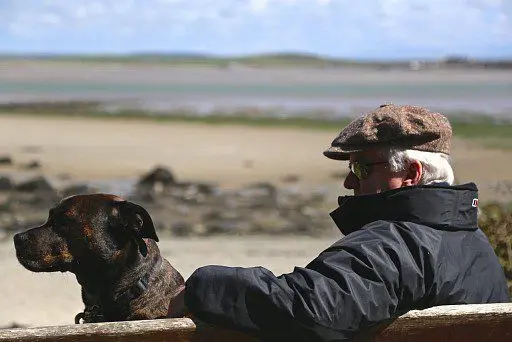
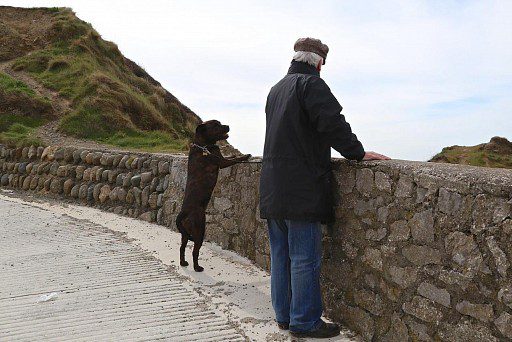
Education and training
Keeping a dog with a fighting past imposes a number of obligations on its owner. In particular, teaching a pet the basics of behavior and its socialization are tasks that cannot be avoided with all the will, since an ill-mannered and not understanding staff bull is always a threat. Yes, the level of aggression towards humans and our smaller brothers in this breed is reduced, but this does not mean that its representatives are completely harmless.
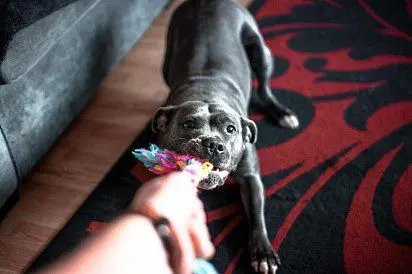
The optimal training program for the Staffordshire Bull Terrier is considered OKD (General Training Course), although simplified options like UGS (Managed City Dog) are also not excluded. The passage of the ZKS (Protection Guard Service) for the staff is not necessary, but in practice it takes place. At the same time, it is important to understand that some fantastic bodyguard will not come out of a representative of this breed. First, the growth of the Staffordshire Bull Terrier does not make a big impression on bullies. Secondly, after the animal has been trained, all you can count on is barking at an approaching stranger and trying to attack an enemy who is near the pet at a distance of 2-3 m. It seems to be not so bad, but, you see, that a barking staff bull and a clattering Caucasian shepherd dog These are two completely different levels of threat.
In the training and education of the Staffordshire Bull Terrier, you will have to be patient and work on asserting your own authority. Representatives of this breed are stubborn creatures who love to twist the requirements placed on them and act according to their own preferences. For all that, putting pressure on staffies will not work: these dogs cannot stand harshness and, in response to rough treatment, they generally stop listening to the orders of the owner.
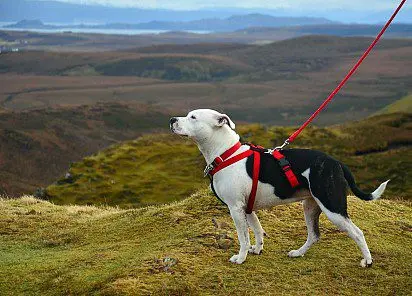
It is very important to form the skill of obeying commands in a pet in time. You can be confident in the Staffordshire Bull Terrier only if he executes the order immediately and without hesitation, which is why experts do not recommend repeating the command twice. Staffbulls are also cunning, who have mastered the art of manipulation to perfection. Let them “not hear” the call once, and then they will make you beg them whenever you need to do something.
In raising a tiny puppy, you can and should follow a standard program. First, they learn the nickname with the baby, to which he should respond. By the way, as in the case of commands, it is better not to abuse repetitions here. At 2.5 months, if the weather permits, you can go outside with the Staffordshire Bull Terrier, developing the habit of calmly responding to unfamiliar phenomena and sounds. After 2-3 weeks, when the puppy gets used to the street noise, he needs to find a company for communication. The best option is a small party of several puppies and adult phlegmatic individuals, in which the young staffy should occupy the appropriate hierarchical niche.
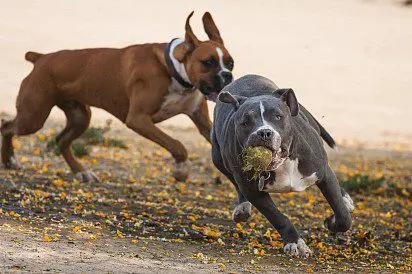
The Staffordshire Bull Terrier is an addictive and emotional dog, so monotonous lessons get bored of her. For better assimilation of the educational material by the pet, it is recommended to break the hourly lesson into five minutes, in between which the four-legged schoolboy is allowed to fool around and play to his heart’s content. Remember that Staffordshire Bull Terrier puppies are dominated by short-term memory, thanks to which kids grasp new knowledge in a split second and forget them just as quickly. So don’t try to fit a bunch of tricks into one session. Better fully work out one skill, honing it to perfection in subsequent training. It is better to start training a Staffordshire Bull Terrier puppy with elementary dynamic skills, that is, with an approach to the call of the owner, a toy tray, movement next to a person during a walk (without tension on the leash). When the material is learned and worked out to automatism, it can and should be supplemented, since the principle “from simple to complex” has been and remains the best method of teaching staff bulls.
Maintenance and care
The Staffordshire Bull Terrier is a sociable dog and unadapted to our weather realities, so its place is in an apartment or a private house. Do not worry, the Staffbull is, of course, energetic and jumpy, but it is completely undemanding to spatial conditions and is quite compact in itself. But you will have to fork out for toys for a pet: staffies love to chew on some elastic little thing at their leisure. In addition, in the process of training a puppy, squeaker balls and other rubber accessories are very useful.
Hygiene
The short coat of the Staffordshire Bull Terrier is not particularly necessary to take care of. Usually staff bulls are combed during the seasonal molt (spring-autumn), but there is no systematic need for this. Moreover, combing for the breed is more of a stimulating massage than a procedure to improve appearance. Tight-fitting dog hair even in the off-season looks clean and tidy, which, however, does not prevent dead hairs from intensively crumbling and covering carpets.
On a note: if the Staffordshire Bull Terrier lives in an apartment where it is too dry, warm and there are no air humidification systems, it can shed not seasonally, but all year round.
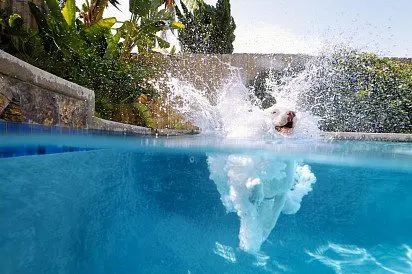
Once a month it is necessary to allocate time for bathing the dog. Wash staffies with a diluted shampoo for shorthaired breeds, and dry without a hair dryer, blotting the wet coat with a towel and combing it with a rubber mitten. By the way, it is strictly forbidden to let out a not quite dry Staffbull outside, unless you want to kill the animal, so there are no promenades for 2-3 hours after taking a bath. In winter, you can wash your dog less frequently, for example, once every 2-3 months.
Caring for the eyes and ears of the Staffordshire Bull Terrier is simple. About once a week, the pet should examine the ears and remove the sulfur and dirt accumulated inside with a damp cotton pad. An unpleasant smell from the ear funnel, as well as rashes inside it, is a reason to visit the veterinarian. You will have to allocate at least a couple of minutes a day for examining the eyes in order to remove the lumps of mucus that gather in the corners of the eyelids. In general, inflammation of the mucous membrane of the eye is not typical for staff bulls, but if you suddenly notice that the pet periodically “cries”, you need to talk to a specialist in canine diseases.
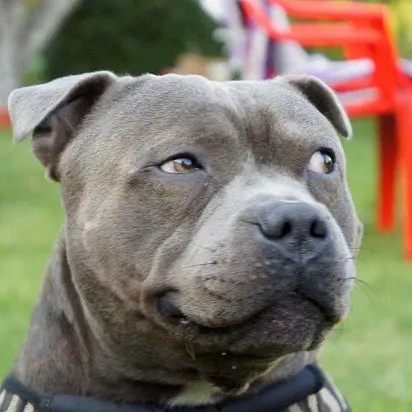
You will have to thoroughly tinker with brushing the teeth of the Staffordshire Bull Terrier, since in order to maintain the health and cleanliness of the oral cavity, it is necessary to dive with a brush into the pet’s mouth at least 3-4 times a week. Clipping of the claws for the Staffbull is also required. In the warm season, the claws of productively walking dogs grind off when walking, so all that remains for the owner is to trim their ends once a month with a nail cutter and polish them with a nail file. In winter, the procedure will have to be carried out more often, after soaking the claws in warm water to make the keratinized part softer and more pliable.
paddock
Good physical relaxation is necessary for Staffordshire Bull Terriers, but everything must be in moderation. It is undesirable to load puppies up to a year with intensive training, racing for a bicycle, games of tug and other sports pleasures designed for adults, mature individuals. And of course, no walks under the scorching sun. Due to the fact that the muzzles of the Staffordshire Bull Terriers are short, their thermoregulation processes go at a somewhat slower pace, so overheating is easy for the animal. In winter, it is also better to reduce the duration of walking for puppies to a 10-15-minute run around the yard.
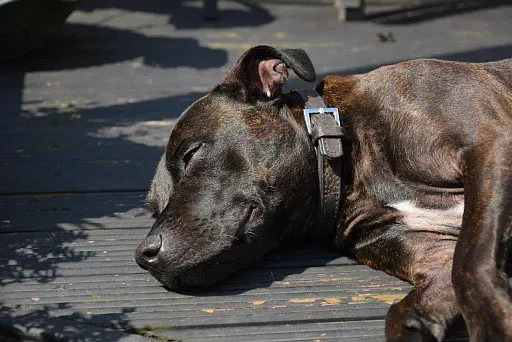
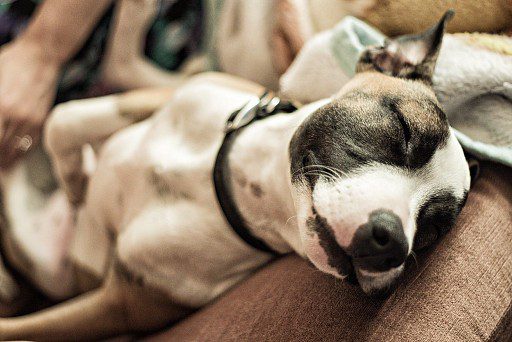
Teenagers and adult dogs are taken outside on a leash, and with males it is worth walking longer, since it takes a certain time for the odorous “territory marking”. By weight, Staffordshire Bull Terriers are subject to the Dog Walking Act, which prohibits animals from appearing in public places without a muzzle. Therefore, in order not to conflict with others, it will be necessary to accustom the staff to this object that is unpleasant for him.
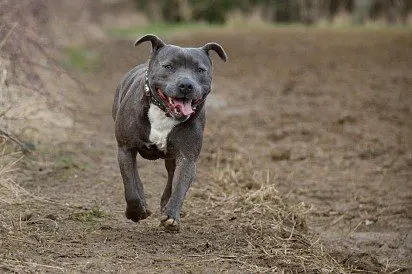
Do not forget that inside each staff bull, a typical representative of the terrier tribe is sensitively dozing, for whom a walk is another opportunity to test their own strength in digging flower beds and digging pits. You should not limit your pet in this activity. It is better to look for a secluded corner outside the city or in your own backyard, where the staff can come off in full, without causing damage to the surrounding landscape.
Staffordshire bull terriers are not enthusiastic about Russian frosts, but this is not a reason to refuse them winter walks, especially since adult dogs tolerate temperatures down to -15 ° C normally. Buy insulated overalls for your pet, put on protective slippers that will protect the animal’s paws from exposure to reagents, and you can safely go on an excursion to the park or a Sunday jog through the city streets.
Feeding
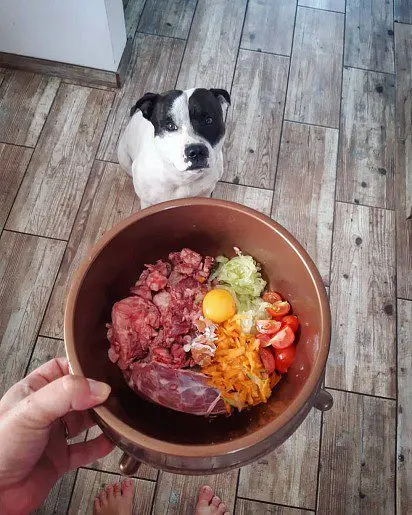
Until the age of 12 weeks, Staffordshire Bull Terrier puppies are fed 5-6 times a day, by the beginning of the 4th month of life, reducing the number of feedings to four. Six-month-old staffies eat 3 times a day, but after the animals are one year old, they should be transferred to a two-time diet. Typically, the diet of a Staffbull puppy consists of easily digestible proteins, the source of which is fermented baked milk and one percent kefir, chicken / turkey breast, boiled fillet of sea fish, cottage cheese. It is better for babies to cook porridge from rice and buckwheat, and as natural vitamin supplements, introduce boiled chicken yolk (half), vegetable oil, seasonal vegetables that have undergone heat treatment into the diet.
Adult animals are given not only poultry meat, but also lean beef, as well as rabbit meat at the rate of 25 g of product per kilogram of dog weight. Offal Staffordshire Bull Terriers can be no more than twice a week. In addition, due to their reduced nutritional value, the portion will have to be increased by a third, that is, instead of 25 g of meat, about 35 g of tripe. Industrial feed is also not prohibited, but experts do not recommend mixing “drying” with natural food. As for choosing the right dry food, everything is standard here: we buy premium and super-premium varieties and refuse economy varieties from the supermarket.
Good to know: Staffordshire Bull Terriers love to eat solidly and densely. In addition to meat, dogs are very respectful of apples, as well as boiled cabbage, the abuse of which provokes increased gas formation in them. Therefore, in order not to suffer from regular “gas attacks” arranged by a pet, it is better to carefully monitor its diet.
Health and disease of Staffordshire Bull Terriers
Staffordshire Bull Terriers are considered one of the most mentally stable and physically strong breeds. As for genetically determined ailments, the most susceptible staffies are urolithiasis, intestinal volvulus, entropion, hip dysplasia, hyperadrenocorticism, cataracts and cancer. Most popular catteries examine their litters for joint dysplasia and patella, which helps to identify and exclude sick individuals from further breeding. Genetic testing for HC (hereditary cataract) and L2HGA (L2-hydroxyglutaric aciduria or genetic epilepsy) is also desirable, as effective treatments have not yet been found.
How to choose a puppy
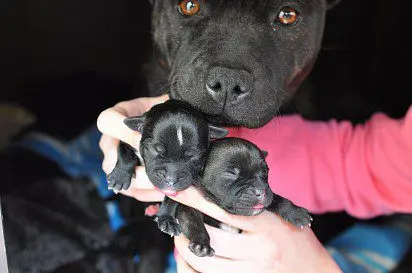
- A normally developing Staffordshire Bull Terrier puppy should be playful, curious and very active (with age, the animals become calmer). If the baby is too phlegmatic and thoughtful, something is clearly wrong with him.
- If a small staff bull does not make contact, becomes hysterical and tries to hide, this signals an unstable psyche. Usually, before buying with puppies, they pass the Campbell test, which helps to determine the individual character traits of each baby.
- Males and females of the Staffordshire Bull Terrier differ both in appearance and in character. If the aesthetic characteristics of the puppy play an important role for you, it is better to choose dogs. They are larger, stronger and generally have more pronounced breed features. Staffbull females are suitable for those owners who need a more manageable pet. “Girls” are more attached to the family, they are more temperamental, not prone to leadership and are easier to train.
- Carefully inspect the kennel and the habitats of the puppies. Toddlers and their parents should not huddle in cramped dirty cages.
- Ask the breeder or kennel staff for the results of a litter screening for genetic diseases. If there are no certificates, the seller is most likely inexperienced and is breeding solely for the sake of personal enrichment.
Photo of Staffordshire Bull Terrier puppies
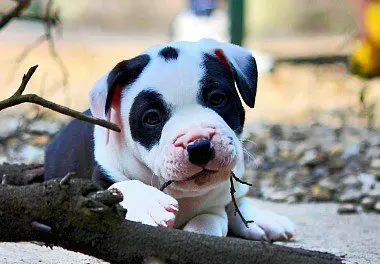
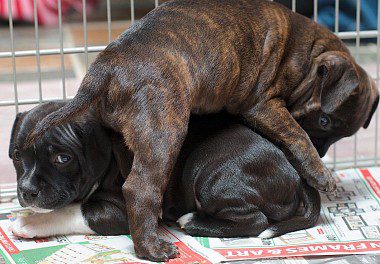
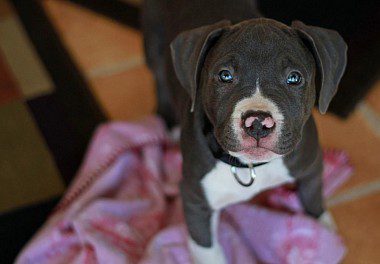
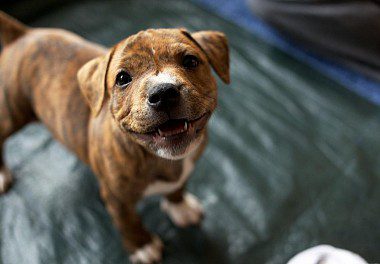
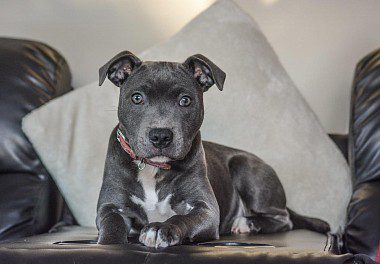
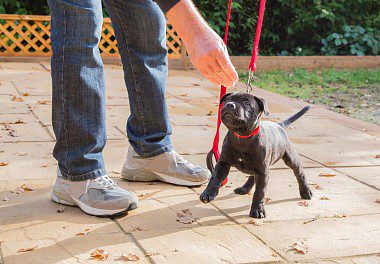
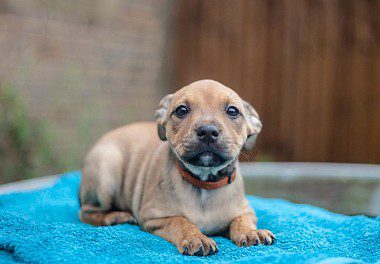
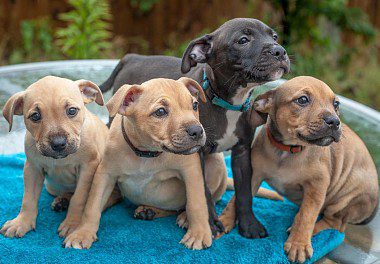
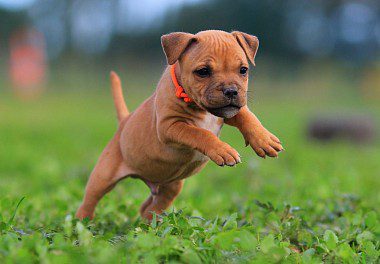
Staffordshire bull terrier price
The average price tag for offspring obtained from interbreeding (female and male from different countries) and tested for hereditary diseases is 900 – 1100$. Staffordshire bull terrier puppies with a promising exterior, but from less famous parents, will cost around 500 – 700$. Often you can find ads for the sale of bred staff bulls. As a rule, they are given not by breeders, but by puppy owners who could not cope with his upbringing. These dogs are sold at a reduced cost – about 150 – 250$, while you should not forget that Staffordshire Bull Terriers need early socialization, and when you buy a teenage puppy, you get an animal with already half-formed and not always good habits that will be difficult to correct.



